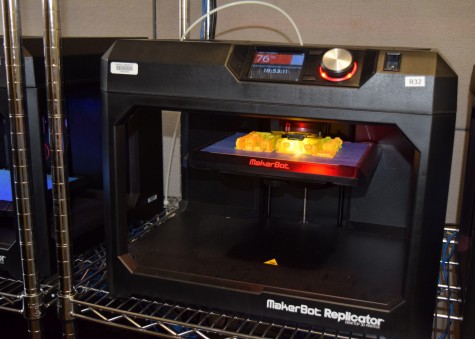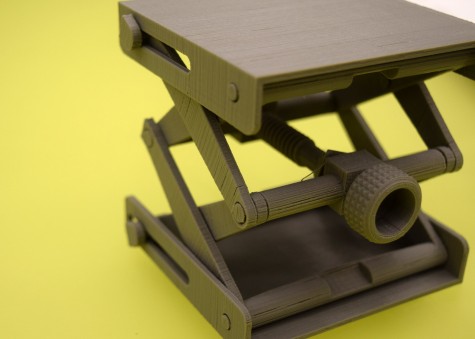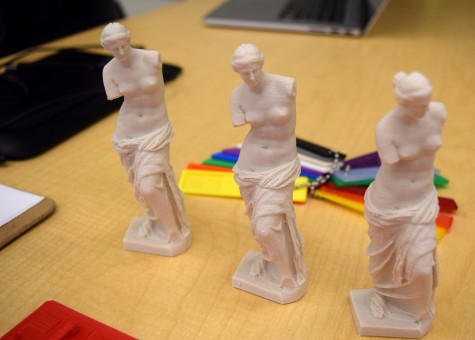3D Printing on the rise at UMass
March 23, 2016
Emma Cook just wanted some rubber ducks. Cook, a Classics major, wanted to give them to her boyfriend as a memorable Valentine’s Day present. But she didn’t want to give him just any ducks; she wanted them to be unique. She didn’t know where she could find what she was looking for so she decided to go to the 3D printing lab on campus. She heard it had recently opened to all students and that at the lab, located on the third floor of the W.E.B. Du Bois Library at the University of Massachusetts Amherst, you can print anything from engines to – you guessed it – rubber ducks. Cook didn’t come with a blueprint the way she was supposed to, but a staff member helped her create one.
“One of the guys working there found a blueprint for me. All in all, it was very easy and the entire process didn’t take very long,” said Cook.

There are 48 3D printers split between two locked rooms and set on metal racks in rows. They are jet black, sleek and sound like normal printers; a reddish-orange color glows from them as they lay down yellow filament, the ink 3D printers use to make projects. When it hardens, it feels like plastic.
Supervisor Dennis Spencer, 38, said some 2,400 print jobs have been completed. They range from neck-brace prototypes to Pompeii artifact models. He said 66,000 grams of filament have been used by the approximately 260 students that have come in to request print jobs.
Spencer and his colleagues are happy to work with anyone who wants an item printed. Finding a design for a model that will work is part of the process to create a 3D print. Spencer said it is rather easy. People can use websites with no copyright licensing to download and use the models they find. One website they recommend is thingiverse.com, a website that allows people to download files they can edit and print. The supervisor said people can use software to create their own 3D design, or they can make it using a scanner at the lab.
Many different academic departments have found use for the 3D printers. Spencer said the Architecture professors and students use the 3D printers to create models of structures and buildings. The Department of Mechanical and Industrial Engineering added 3D printing to its curriculum; the department believes it helps students visualize what they’re learning.
Spencer believes the medical field could benefit from 3D printing, too. Students have made many medical prototypes, or models, at the lab. One student scanned his arm and made a prototype for a custom cast.
“In theory, it’s supposed to be stronger and it had an open, hexagonal pattern so your skin could breathe,” said Spencer.

Printing 3D objects has been especially revolutionary for robotics. Justin Marple, a computer systems engineering major, has made many projects with the 3D printers on campus.
“What I normally get printed are parts for robots that would be difficult to machine out of aluminum or steel,” said Marple. He said many parts would also be too heavy if made out of aluminum or steel.
“I’ve had wheel hubs, motor mounts, and camera mounts 3D printed,” he added.
There can still be some downsides to 3D printing. Marple said his experience with it has been good, but some of it has been trial and error. He said many objects he’s printed have needed some modifications. At times, he had to sand down a model for it to work properly, or needed to drill out screw holes because the projects come out smaller than designed. But it’s worth it.
“The time it takes to drill these holes or smooth out a piece is almost always worth the time saved machining these objects,” he said.
It can take a long time for a model to print. Marple said it has taken an entire day for his models to finish printing. Although it is not too expensive, it costs 15 cents per gram of filament used.

There was talk at the library about getting 3D printers back in 2013. Spencer said the university first looked into purchasing three to five 3D printers. However, the library was able to buy 48 printers and some scanners in the summer of 2014 with help from Friends of the Library, a donor group. The lab officially opened on Jan. 12, 2015.
“That first semester was just about learning how to operate [a lab] this large,” Spencer said.
Although the lab was running, Spencer and his colleagues had to do a lot of testing first. They visited engineering and education classes to find things to print in 3D. Spencer said he wanted to have examples created of what they could make in the lab. In fall 2015, the lab opened to the UMass Amherst campus and the other colleges in the Five College Consortium.
Spencer said they want the public to realize 3D printing is accessible to anyone.
“Either people aren’t aware of us, or they may not see 3D printing as accessible. We’re trying to inform people,” he said.
He’s correct: Many students on campus wonder if it’s accessible to them or how they can use them.
Alex Karle, a sophomore computer science and math major, didn’t think it was easy to use them.
“I know about the 3D printers, but have never attempted to use them. I assumed we would need some sort of training to use it, which could be time consuming,” said Karle.
Students don’t operate the printers. Rather, you create and put in a request for a project, and a staff member creates the model for you. On the lab’s website, students can find detailed instructions on how to create and submit a request for a print job.

But many students have not even heard of the 3D printing lab yet. The supervisor said this is because they haven’t advertised much yet.
“We haven’t been promoting as heavily as we normally would,” Spencer said. This is due to lack of staffing. Since Spencer was recently made supervisor, the library still needs to fill his old spot with someone new. For now, he’s doing “double duty” working both positions.
The lab still functions, despite missing a staff member. At the moment, they’re still trying to get the word out. Their busiest times are the holidays and towards the end of the semester. Class projects have priority, so Spencer said it’s best to get a request in early if you want it by a specific day. It may also take over 24 hours to finish your piece.
Despite some of the drawbacks of 3D printing, Marple recommends it.
“It’s not an end-all-be-all type of technology, but it definitely makes a huge impact!”
For more information on 3D printing, visit their website.
Email Katie at [email protected].
